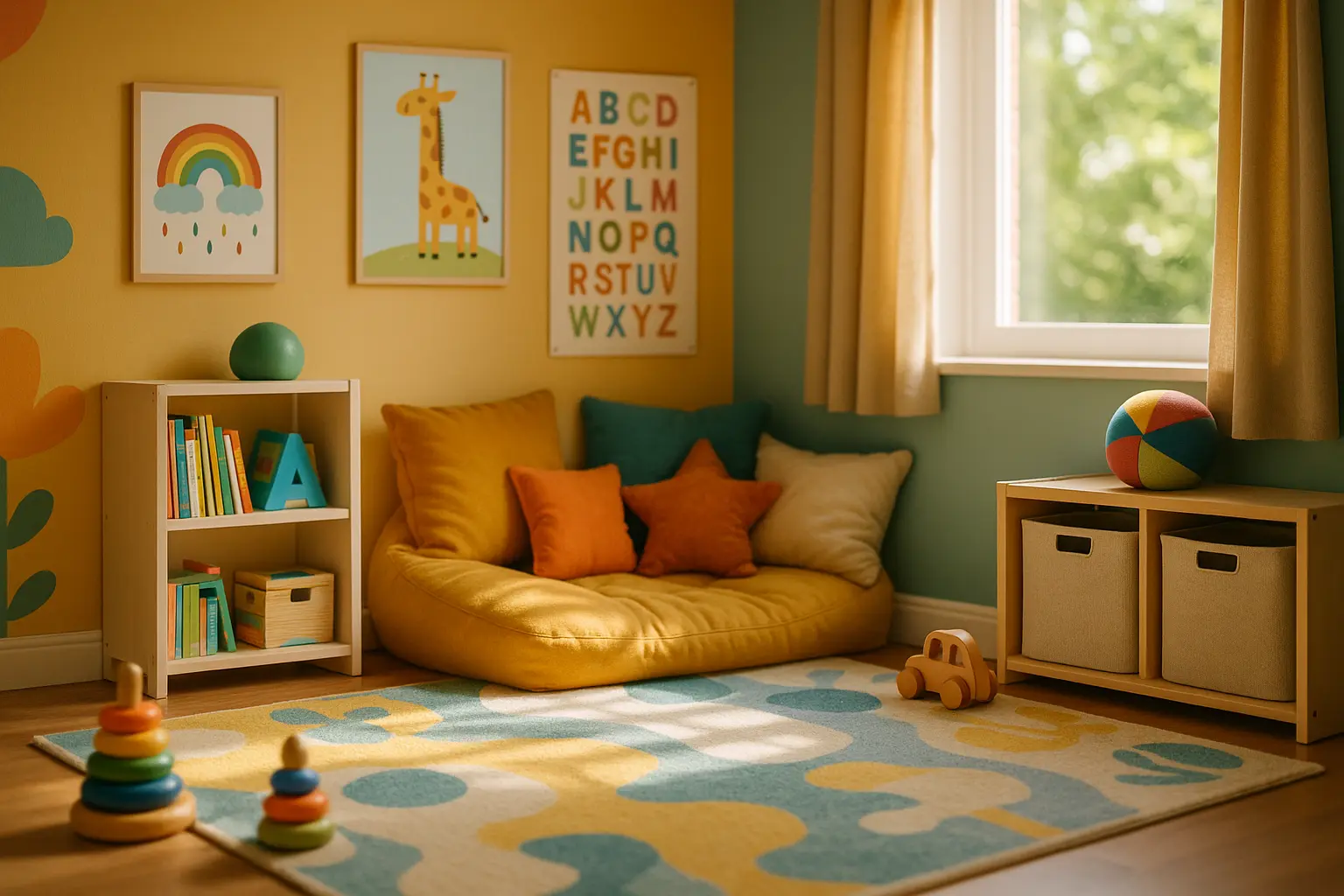In the heart of every thriving classroom lies a children’s room that not only welcomes young minds but also nurtures their innate curiosity. As we enter 2025, our collective understanding of the importance of design and the sensory environment in a child’s learning journey has evolved, paving the way for innovative spaces that inform, engage, and inspire.
Our goal? To create rooms that double as canvases for imagination and bases for education, blending fun with function. Let’s embark on a journey to explore how we can craft spaces that are as stimulating as they are safe, ensuring every child feels empowered and every corner brims with potential.
Designing Spaces that Spark Curiosity
Every child’s room should be a haven of wonder, a place where learning is woven effortlessly into the fabric of daily play. A well-designed space can serve as the backdrop for countless adventures, nurturing a child’s innate curiosity and shaping their understanding of the world.
When we talk about design, we’re not just referring to aesthetics but to the strategic arrangement of materials, colors, and textures that can ignite a child’s imagination. From color palettes that evoke calmness to playful elements that beckon exploration, each component plays a pivotal role in transforming a simple room into a living, breathing environment.
To create such spaces, flexibility is key. Modular furniture, adjustable lighting, and moveable partitions allow us to tailor the environment to the needs of the moment. This adaptability ensures that the room can morph from a reading nook to an activity hub in the blink of an eye, catering to the evolving interests of young learners.
Moreover, incorporating natural elements like plants and sunlight further enriches the sensory experience, grounding children in their surroundings while fostering a connection to the world outside. By prioritizing these design philosophies, we craft spaces that do more than accommodate children – they invite them to explore, create, and learn.
The Vital Role of Sensory Environments
In our quest to create enriching rooms, we must pay homage to the myriad ways children perceive and interact with their environment. Sensory learning is paramount in early childhood education, offering tactile, auditory, and visual experiences that cater to diverse learning styles.
Engaging the senses goes beyond traditional classroom setups. It involves integrating multisensory experiences that stimulate a child’s natural inclination to explore. Textured walls, interactive boards, and soundscapes can transform a space into an educational wonderland. These elements not only enhance engagement but also foster emotional connections to learning.
However, creating a sensory-rich environment is akin to walking a tightrope. Balance is essential. An overload of stimuli can overwhelm rather than delight. By curating an array of sensory inputs, we can ensure that every child, regardless of their sensory preferences, feels at home.
Incorporating soft fabrics, natural lighting, and ambient music can help maintain the equilibrium between stimulation and comfort. Such environments nurture not only cognitive skills but also emotional well-being, laying the groundwork for lifelong learning.
Ultimately, a thoughtfully curated sensory environment is a gift that keeps giving, offering endless opportunities for children to learn, grow, and thrive.
Materials and Storage: The Twin Pillars of Functionality
In any educational space, the materials we choose and how we store them are as crucial as the activities they facilitate. They are the unsung heroes that support creativity and organization, ensuring seamless transitions between learning and play.
Selecting durable materials that can withstand the rigors of active children is essential. From sturdy wooden tables to washable rugs, the right materials ensure longevity and safety, allowing children to engage without reservation. These choices reflect our commitment to creating spaces that are both inviting and enduring.
Equally important is the role of storage. Well-designed storage solutions encourage independence and responsibility, allowing children to self-manage their environment. Open shelves, labeled bins, and accessible cubbies empower young learners to choose their activities and tidy up afterward. In doing so, we imbue values of accountability and organization, crucial life skills that extend beyond the classroom.
Moreover, strategic storage facilitates fluid transitions between activities, ensuring that the room can accommodate various learning styles and teaching strategies. With everything in its place, students are free to explore and discover their interests, fostering a sense of agency and curiosity.
In the interplay of materials and storage, we find the pillars that uphold a room’s functionality, creating an environment ripe for exploration and learning.
Fostering a Sense of Belonging with Purposeful Areas
Designing spaces where children feel a deep sense of belonging goes beyond physical layout; it delves into creating purposeful areas that cater to diverse needs and promote a culture of inclusivity and respect.
These areas, whether a cozy reading nook, a vibrant art corner, or a collaborative project station, serve as microcosms of the larger room, each with its distinct purpose and appeal. They provide children with options, allowing them to choose activities that resonate with their interests and moods.
Creating such areas involves thoughtful consideration of children’s developmental stages and preferences. A quiet zone with soft seating and calming decor can offer solace to those seeking a moment of reflection, while a bustling play zone with kinetic toys and building blocks can serve as an outlet for youthful energy.
Purposeful areas also enable educators to tailor their approaches. They can facilitate group activities in a wide-open space or hold one-on-one sessions in a more private setting. This flexibility supports differentiated instruction, ensuring all students receive the attention and support they need.
In the end, fostering a sense of belonging within these purposeful areas reinforces the idea that every child is valued and every interest is acknowledged, creating an inclusive and nurturing environment where children are inspired to reach their full potential.
As we draw our exploration to a close, the importance of crafting rooms that are both stimulating and safe becomes evident. Each space we design is an opportunity to shape young minds, to leave a lasting imprint that extends beyond the walls of the classroom.
Incorporating elements that cater to the senses, ensuring functionality through durable materials and thoughtful storage, and cultivating areas that foster belonging, all converge to create environments that resonate with children. These rooms lay the foundation for learning and growth, spaces where imagination knows no bounds and where every child feels at home.
As we continue to evolve in our understanding of learning environments, let us remain committed to creating spaces that inspire, nurture, and empower, ensuring that in every corner of a child’s room, memories are crafted with care and intention.
FAQ
How can I design a child’s room to encourage creativity and learning?
Designing a child’s room that fosters creativity and learning involves incorporating elements that stimulate imagination and curiosity. Consider using vibrant colors, versatile furniture that can adapt to different activities, and including a variety of books and educational toys. Creating dedicated zones for reading, playing, and art can further inspire children to explore different interests.
What are some safety tips to keep in mind when setting up a child’s room?
Ensuring safety in a child’s room involves using furniture with rounded edges, securing heavy items like bookshelves to the wall, and keeping small items out of reach to prevent choking hazards. Additionally, opt for non-toxic paints and materials, and ensure cords and electrical outlets are safely covered.
How can I maximize storage space in a small child’s room?
To optimize storage in a small child’s room, use multi-functional furniture like beds with built-in drawers or desks with storage compartments. Wall-mounted shelves and hooks can help keep the floor space clear, while baskets and bins can organize toys and clothes neatly.
What are some ways to make a child’s room adaptable as they grow?
Designing a flexible room that grows with your child involves choosing timeless furniture and decor that can easily be updated. Opt for neutral wall colors and introduce personality through interchangeable elements like artwork, rugs, and bedding. Modular furniture and adjustable systems can accommodate changing needs over time.
How can I incorporate nature into a child’s room?
Bringing nature into a child’s room can create a calming and refreshing environment. Introduce potted plants that are safe for children and require minimal maintenance. Use nature-inspired colors and materials, such as wood or bamboo, and consider a nature-themed mural or wallpaper to bring the outdoors inside.


